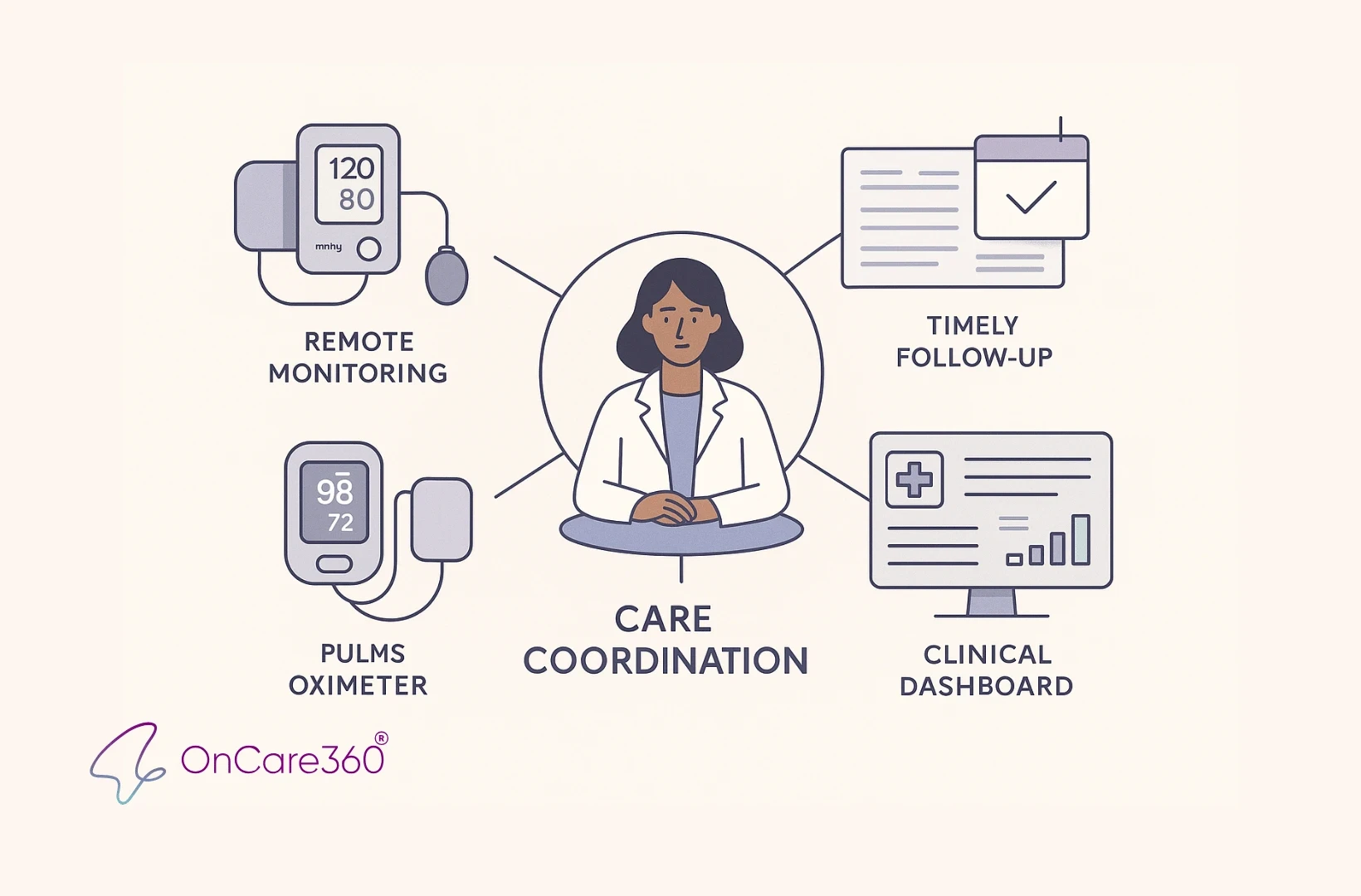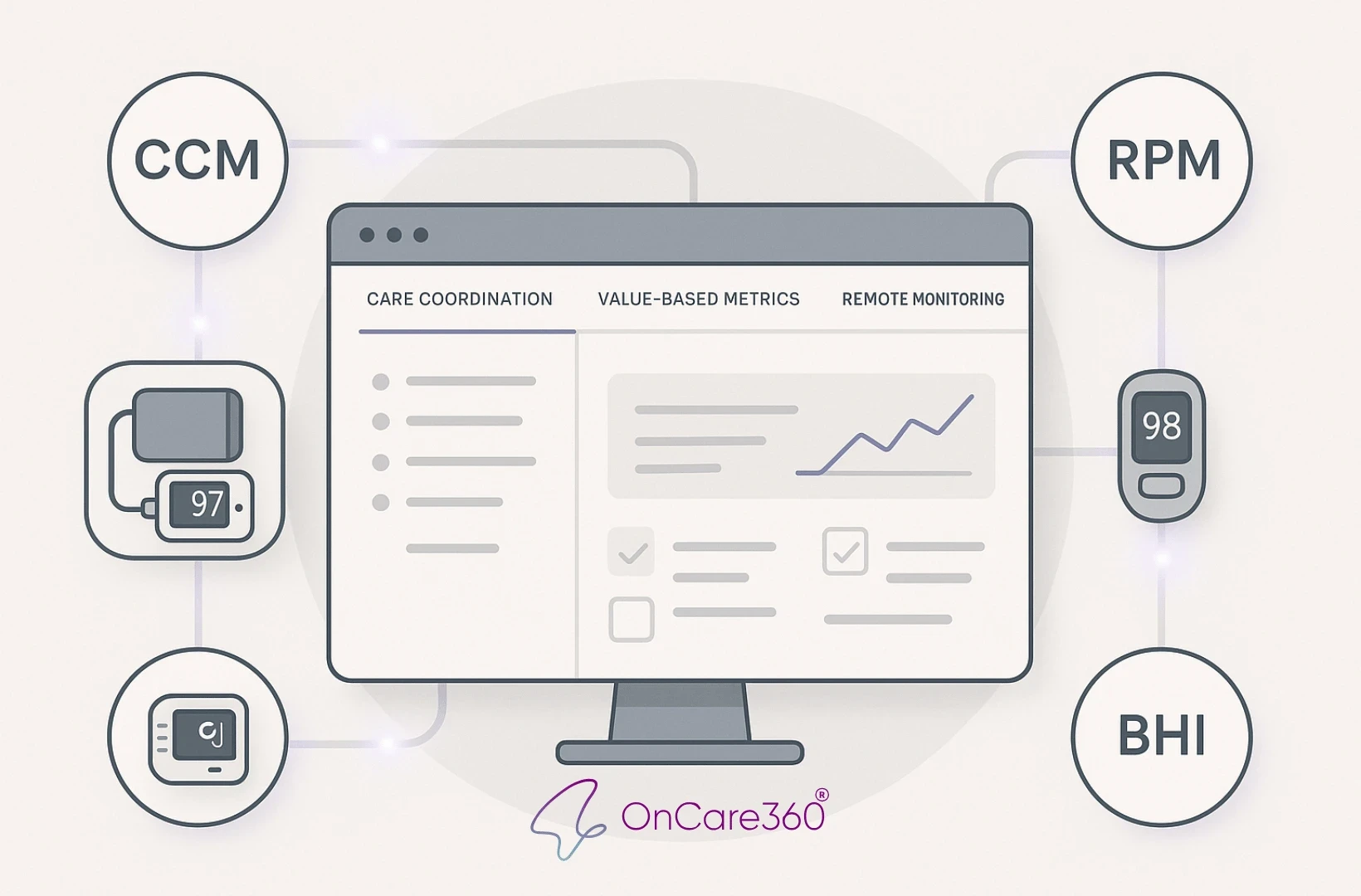Patient Population Focus for CCM: Who Benefits Most from Chronic Care Management




OnCare360
Mar 7, 2025
Chronic Care Management (CCM) is one of Medicare’s cornerstone programs for improving outcomes in patients with multiple chronic conditions. While the billing rules are clear, program success depends on identifying the right patient cohorts—those who will benefit most from monthly follow-up, coordinated care planning, and proactive intervention.
This article reviews population characteristics that align with CCM, the clinical and operational criteria for enrollment, and considerations for program equity.
Why Patient Selection Matters
CCM requires investment from both clinical and administrative teams. Enrolling every eligible patient may dilute resources and limit measurable results. By stratifying the population and prioritizing those most likely to improve with ongoing engagement, practices can:
Reduce avoidable hospitalizations
Improve disease control measures (A1C, BP, LDL)
Enhance patient satisfaction and self-management skills
Maximize return on program resources
High-Value Populations for CCM
Based on CMS guidelines and practice experience, these patient groups show the strongest alignment with CCM:
1. Patients with Two or More Unstable Chronic Conditions
Examples: Diabetes with uncontrolled A1C and hypertension, COPD with frequent exacerbations, CHF with volume instability.
These patients benefit from medication titration, lifestyle support, and coordinated specialist follow-up.
2. Recently Discharged Patients with Ongoing Needs
Patients discharged from hospital or skilled nursing for chronic disease complications often face gaps in care. CCM offers a structured safety net between visits.
3. Seniors with Functional or Cognitive Limitations
Older adults with multiple chronic illnesses may lack transportation, health literacy, or memory capacity to manage complex regimens independently.
4. Rural or Underserved Populations
CCM can bridge geographic and access barriers by coordinating services remotely and aligning community resources.
Populations Less Suitable for CCM
While eligibility criteria are broad, some patients may be better served through other programs:
Patients with a single chronic condition (better suited for PCM)
Hospice or palliative care patients whose goals differ from CCM objectives
Individuals unable to provide informed consent or engage in monthly contact
Social Determinants and Equity Considerations
CCM should address barriers beyond clinical diagnosis:
Language & Cultural Factors: Offer multilingual care coordination and culturally appropriate care plans.
Connectivity: Ensure patients have reliable phone or digital contact for monthly interactions.
Support Network: Include caregivers in care planning to enhance adherence.
Incorporating SDOH screening into enrollment helps identify needs early.
Enrollment Criteria and Workflow Integration
A structured enrollment checklist can ensure consistent, equitable inclusion:
Diagnosis Requirement: Two or more chronic conditions expected to last ≥12 months and at significant risk of decline.
Care Plan Preparedness: Ability to create and share a comprehensive care plan accessible to the patient and care team.
Monthly Engagement Capability: Patient reachable for at least one 20-minute interaction per month.
Provider Capacity: Care team bandwidth to deliver consistent follow-up without compromising quality.
Embedding these criteria into EHR prompts or case management workflows improves efficiency.
Key Takeaways
CCM works best when focused on high-need, high-risk populations where monthly contact will meaningfully improve outcomes.
Social and logistical barriers must be factored into patient selection to ensure equitable benefit.
A standardized, repeatable enrollment process supports compliance and program performance.
Contact us today for a tailored strategy session.
Why Patient Selection Matters
CCM requires investment from both clinical and administrative teams. Enrolling every eligible patient may dilute resources and limit measurable results. By stratifying the population and prioritizing those most likely to improve with ongoing engagement, practices can:
Reduce avoidable hospitalizations
Improve disease control measures (A1C, BP, LDL)
Enhance patient satisfaction and self-management skills
Maximize return on program resources
High-Value Populations for CCM
Based on CMS guidelines and practice experience, these patient groups show the strongest alignment with CCM:
1. Patients with Two or More Unstable Chronic Conditions
Examples: Diabetes with uncontrolled A1C and hypertension, COPD with frequent exacerbations, CHF with volume instability.
These patients benefit from medication titration, lifestyle support, and coordinated specialist follow-up.
2. Recently Discharged Patients with Ongoing Needs
Patients discharged from hospital or skilled nursing for chronic disease complications often face gaps in care. CCM offers a structured safety net between visits.
3. Seniors with Functional or Cognitive Limitations
Older adults with multiple chronic illnesses may lack transportation, health literacy, or memory capacity to manage complex regimens independently.
4. Rural or Underserved Populations
CCM can bridge geographic and access barriers by coordinating services remotely and aligning community resources.
Populations Less Suitable for CCM
While eligibility criteria are broad, some patients may be better served through other programs:
Patients with a single chronic condition (better suited for PCM)
Hospice or palliative care patients whose goals differ from CCM objectives
Individuals unable to provide informed consent or engage in monthly contact
Social Determinants and Equity Considerations
CCM should address barriers beyond clinical diagnosis:
Language & Cultural Factors: Offer multilingual care coordination and culturally appropriate care plans.
Connectivity: Ensure patients have reliable phone or digital contact for monthly interactions.
Support Network: Include caregivers in care planning to enhance adherence.
Incorporating SDOH screening into enrollment helps identify needs early.
Enrollment Criteria and Workflow Integration
A structured enrollment checklist can ensure consistent, equitable inclusion:
Diagnosis Requirement: Two or more chronic conditions expected to last ≥12 months and at significant risk of decline.
Care Plan Preparedness: Ability to create and share a comprehensive care plan accessible to the patient and care team.
Monthly Engagement Capability: Patient reachable for at least one 20-minute interaction per month.
Provider Capacity: Care team bandwidth to deliver consistent follow-up without compromising quality.
Embedding these criteria into EHR prompts or case management workflows improves efficiency.
Key Takeaways
CCM works best when focused on high-need, high-risk populations where monthly contact will meaningfully improve outcomes.
Social and logistical barriers must be factored into patient selection to ensure equitable benefit.
A standardized, repeatable enrollment process supports compliance and program performance.
Contact us today for a tailored strategy session.

Nov 30, 2025
What a High-Performing Care Coordination Workflow Looks Like

Nov 23, 2025
7 Signs Your Practice Needs a Between-Visit Care Model

Nov 16, 2025
10 Workflow Mistakes Killing Remote Care Programs

Nov 9, 2025
How Between-Visit Care Reduces Avoidable Hospitalizations

Nov 30, 2025
What a High-Performing Care Coordination Workflow Looks Like

Nov 23, 2025
7 Signs Your Practice Needs a Between-Visit Care Model

Nov 16, 2025
10 Workflow Mistakes Killing Remote Care Programs

Nov 9, 2025
How Between-Visit Care Reduces Avoidable Hospitalizations

Nov 2, 2025
The Rise of Between-Visit Care in 2026: What Practices Must Know

Oct 26, 2025
CCM vs RPM: Which Care Model Works Better?

Nov 30, 2025
What a High-Performing Care Coordination Workflow Looks Like

Nov 23, 2025
7 Signs Your Practice Needs a Between-Visit Care Model

Nov 16, 2025
10 Workflow Mistakes Killing Remote Care Programs

Nov 9, 2025
How Between-Visit Care Reduces Avoidable Hospitalizations

Nov 2, 2025
The Rise of Between-Visit Care in 2026: What Practices Must Know

Oct 26, 2025
CCM vs RPM: Which Care Model Works Better?
Have questions?
Are you ready to explore the future of healthcare with OnCare360?
Contact us for more information or request a free consultation today.
Have questions?
Are you ready to explore the future of healthcare with OnCare360?
Contact us for more information or request a free consultation today.
Have questions?
Are you ready to explore the future of healthcare with OnCare360?
Contact us for more information or request a free consultation today.
Have questions?
Are you ready to explore the future of healthcare with OnCare360?
Contact us for more information or request a free consultation today.
Have questions?
Are you ready to explore the future of healthcare with OnCare360?
Contact us for more information or request a free consultation today.
Have questions?


